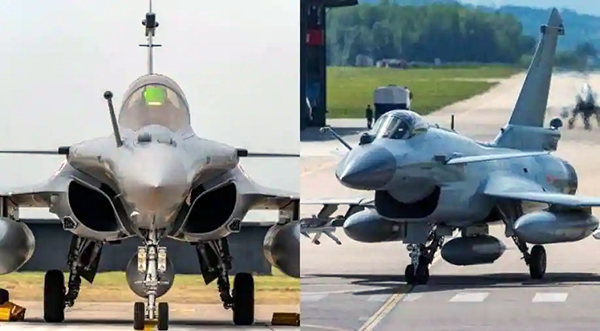Monitoring Desk
A fierce aerial confrontation between Pakistan and India has thrust advanced military technologies into the global spotlight, pitting Chinese-made fighter jets and missiles against Western systems in a rare real-world combat test. The clash, sparked by escalating tensions over Kashmir, has drawn intense scrutiny from militaries, analysts, and defense industries worldwide, eager to assess the performance of cutting-edge weapons and their implications for future conflicts.
The skirmish followed an attack in occupied Kashmir that killed 26 people, prompting India to launch missile strikes early Wednesday, targeting what it called “terrorist infrastructure” in Pakistan and Azad Kashmir. Pakistan retaliated, claiming its Chinese-built J-10C fighter jets shot down five Indian aircraft—three Rafale fighters, one MiG-29, and one Su-30—in an hour-long dogfight involving 125 aircraft at ranges exceeding 160 kilometers (100 miles). India has not acknowledged these losses, though a French Defense Ministry source confirmed at least one Rafale was downed. The clash offers a unique window into the capabilities of rival military technologies.
“This makes any engagement between India and Pakistan a de facto test environment for Chinese military exports,” said Sajjan Gohel, international security director at the Asia-Pacific Foundation, a London-based think tank. “Air warfare communities in China, the US, and a number of European countries will be extremely interested to try and get as much ground truth as they can on tactics, techniques, procedures, what kit was used, what worked and what didn’t,” added Douglas Barrie, senior fellow for military aerospace at the International Institute for Strategic Studies.
The battle showcased Pakistan’s J-10C, a 4.5-generation multirole fighter developed by China’s state-owned AVIC Chengdu Aircraft Industry Group, delivered to Pakistan in 2022. Equipped with an active electronically scanned array (AESA) radar, the J-10C is believed to carry the PL-15 air-to-air missile, which has a reported beyond-visual-range capability of 200–300 kilometers (120–190 miles) in its domestic version, though the export model, likely used by Pakistan, is limited to 145 kilometers (90 miles). India’s Rafale jets, manufactured by France’s Dassault Aviation and inducted in 2020, are armed with the Meteor missile, a radar-guided weapon from Europe’s MBDA consortium, featuring ramjet propulsion and an estimated range exceeding 100 kilometers (62 miles), though exact figures remain unpublished.
Social media has buzzed with speculation about a PL-15 versus Meteor showdown, though no official confirmation exists. “You have arguably China’s most capable weapon against the West’s most capable weapon, if indeed it was being carried; we don’t know that,” Barrie said. A Western industry source cautioned, “At the moment it’s not possible to judge anything. We know so little,” but acknowledged the PL-15’s capability “may be greater than was thought.”
“The PL-15 is a big problem. It is something that the US military pays a lot of attention to,” a defense industry executive said, speaking anonymously. Conversely, Pakistan’s air force highlighted its capabilities in a recent video, describing the PL-15 as “PAF’s potent punch” when paired with the JF-17 Block III fighter.
The clash underscores the shifting alliances in South Asia, a region shaped by great-power rivalries since India and Pakistan’s independence in 1947. During the Cold War, the Soviet Union backed India, while the United States and China supported Pakistan. Today, China, under President Xi Jinping, has solidified its “ironclad” partnership with Pakistan, supplying 81% of its imported weapons from 2020 to 2024, according to the Stockholm International Peace Research Institute (SIPRI). These include the J-10C, the co-developed JF-17 Block III, and the HQ-9B surface-to-air missile system.
“Beijing’s long-standing support for Islamabad—through hardware, training, and now increasingly AI-enabled targeting—has quietly shifted the tactical balance,” said Craig Singleton, a senior fellow at the US-based Foundation for Defense of Democracies. “This isn’t just a bilateral clash anymore; it’s a glimpse of how Chinese defense exports are reshaping regional deterrence.”
India has deepened ties with the United States, sourcing over half its weapons from the U.S., France, and Israel while reducing reliance on Russian systems. “The US finally found India as an alternative partner in the region. As a result, it more or less cut Pakistan off from US arms,” said Siemon Wezeman, a senior researcher in SIPRI’s Arms Transfers Program. “China’s arms supply on the other hand significantly increased—one can say that China used the opportunity to show itself as the only real friend and ally of Pakistan.”
Pakistan’s claim of downing five Indian jets has sparked intense debate. “If Chinese-made J-10Cs were indeed used to shoot down the French-made Rafales, it would be a tremendous boost of confidence in Chinese weapon systems,” said Senior Col. (ret.) Zhou Bo, senior fellow at Tsinghua University’s Center for International Security and Strategy in Beijing. “It will potentially be a huge boost for Chinese arm sales in the international market.”
Bilal Khan, founder of Toronto-based defense analysis firm Quwa Group Inc., added, “If … confirmed, it indicates that the weapon systems at Pakistan’s disposal are, at the minimum, contemporary or current compared to what Western Europe (especially France) offers.” Khan noted the J-10C’s AESA radar and PL-15 provide a significant edge over Pakistan’s older U.S.-made F-16s, which lack modern upgrades.
The Pakistan Air Force (PAF) also operates a larger fleet of American-built F-16s, one of which was used to shoot down a Soviet-designed Indian fighter jet during a flare-up in 2019.
But the PAF’s F-16s are still stuck in an early-2000s configuration – far behind the upgraded versions currently offered by the US – while the Chinese-made J-10CEs and JF-17 Block IIIs feature contemporary technologies such as active electronically scanned array (AESA) radars, Khan said. “So, the F-16s are still a major piece to any PAF-led reprisal, but not the central or indispensable one.”
However, uncertainties cloud the narrative. Barrie, who has written extensively on the PL-15, believes Pakistan likely used the export version with a reduced range. A Western defense industry source analyzing an online image of a missile seeker suggested it showed a Meteor that missed its target, hinting at potential Western shortcomings. Yet India’s successful strikes, which hit multiple targets, raise questions about Pakistan’s Chinese-made HQ-9B air defenses. “If Chinese-origin radar or missile systems failed to detect or deter Indian strikes, that’s bad optics for Beijing’s arms export credibility,” Gohel said.
Antony Wong Dong, a Macau-based military observer, countered, “From China’s perspective, this is essentially a powerful advertisement. It will shock even countries like the United States — just how strong is its opponent, really? This is a question that all countries potentially looking to buy fighter jets, as well as China’s regional rivals, will need to seriously reconsider: how should they face this new reality?”
The clash has reverberated in financial markets. Shares of AVIC Chengdu Aircraft surged 40% this week, rising 17% on Wednesday and 20% on Thursday, signaling growing confidence in Chinese technology. “With Russia set back as a result of its invasion of Ukraine, I’m sure the Chinese have begun pushing hard at Moscow’s traditional markets – e.g., Algeria, Egypt, Iraq, and Sudan – to secure big-ticket sales,” Khan said.
The United States, which accounts for 43% of global arms exports from 2020 to 2024, is developing the AIM-260 missile via Lockheed Martin to counter the PL-15’s beyond-visual-range capabilities. European nations are exploring a mid-life upgrade for the Meteor, potentially enhancing propulsion and guidance, though progress has been slow, according to Janes. “So I absolutely expect the same to be the case with India’s European suppliers, and Pakistan and China are probably sharing the same feedback. If the PL-15 is working as advertised or better than expected, the Chinese would like to hear that,” said Byron Callan, managing partner of Capital Alpha Partners.
The fog of war obscures critical details, including pilot training, rules of engagement, and whether the Meteor was deployed. “There will be audits of what works and what doesn’t work, but I think the other overlay is the proverbial fog of war,” Callan said. Fabian Hoffman, a defense policy research fellow at the University of Oslo, noted that Indian misjudgments—such as underestimating the PL-15’s range—might have amplified Pakistan’s success. “If reports of India losing multiple jets holds up, it would raise serious questions about the IAF’s readiness, not just its platforms. The Rafales are modern, but warfighting is about integration, coordination, and survivability — not just headline acquisitions,” Singleton said.
Pakistan’s air force, however, celebrated the engagement. “(It) is now being characterized as the most intense air-to-air combat engagement between two nuclear-armed nations,” said Salman Ali Bettani, an international relations scholar at Quaid-i-Azam University in Islamabad. “The engagement represented a milestone in the operational use of advanced Chinese-origin systems.”
Global Implications
The clash offers a preview of future conflicts, particularly in the Indo-Pacific, where China and the U.S. are preparing for potential showdowns over Taiwan or beyond. China’s Foreign Ministry remained cautious, with a spokesperson stating Thursday, “I am not familiar with the situation.” However, Chinese Foreign Minister Wang Yi recently called Pakistan China’s “ironclad friend,” reaffirming Beijing’s support.
Militaries from Beijing to Washington are dissecting the battle, seeking lessons for air combat strategies. “This is a question that all countries potentially looking to buy fighter jets, as well as China’s regional rivals, will need to seriously reconsider: how should they face this new reality?” Wong said. (Content courtesy CNN, Reuters and other international media)
Copyright © 2021 Independent Pakistan | All rights reserved




